Wargaming Swiss Army knife Wars Across The World can’t quite muster a Raj quartet yet, but thanks to the Anglo-Zulu War add-on released last week, anyone fascinated by violent Victoriana, can now use it to explore four 19th Century colonial escapades involving Tommy Atkins.
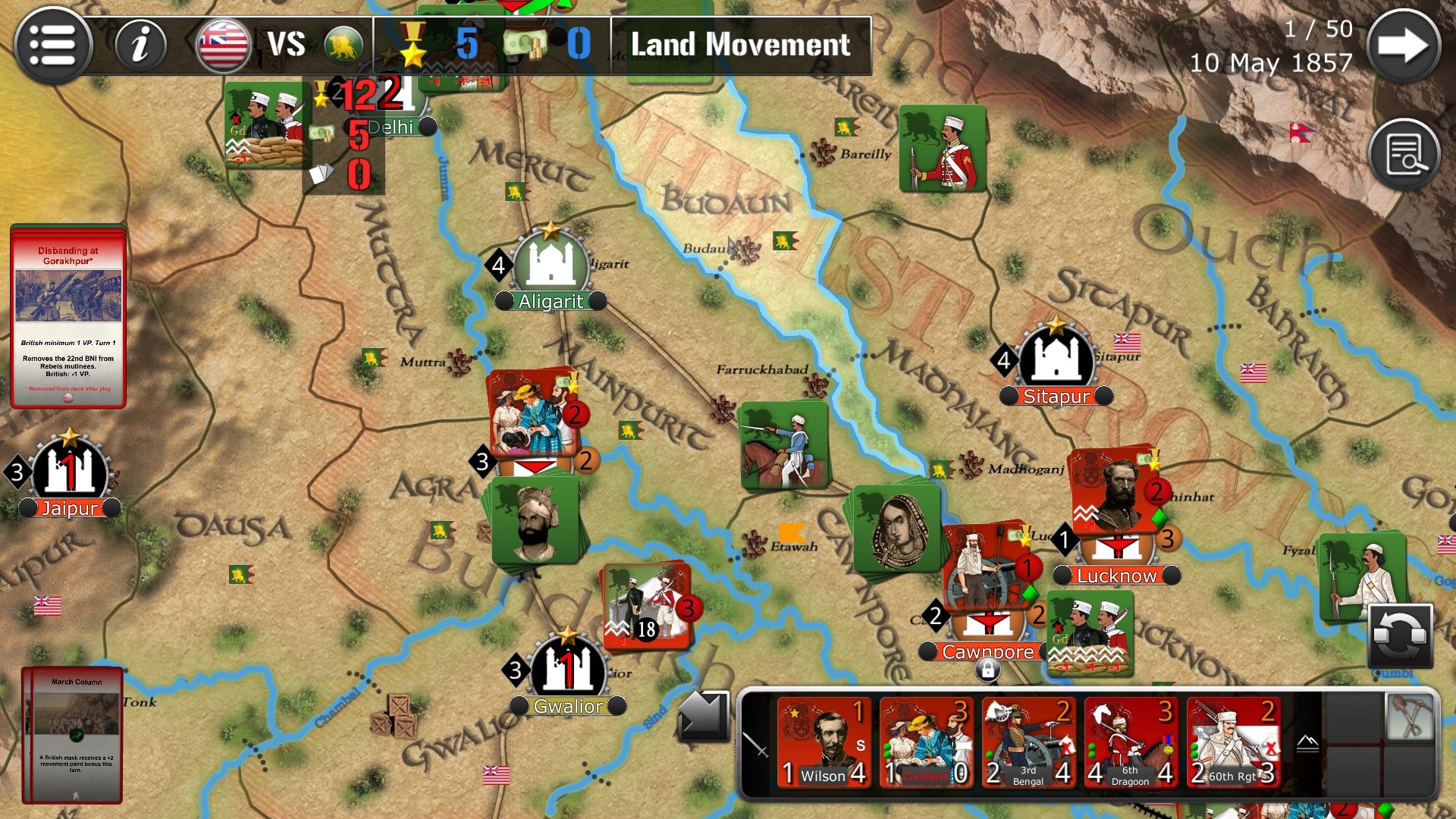
To enjoy Gandamak 1842 (£2), Persia 1856 (£2), Sepoy 1857 (£6), and Zulu 1879 (£4), you’ll need the £7 base game, and a willingness to overlook imperfections that moaning Miniés like me have been grumbling about for nigh on six years.
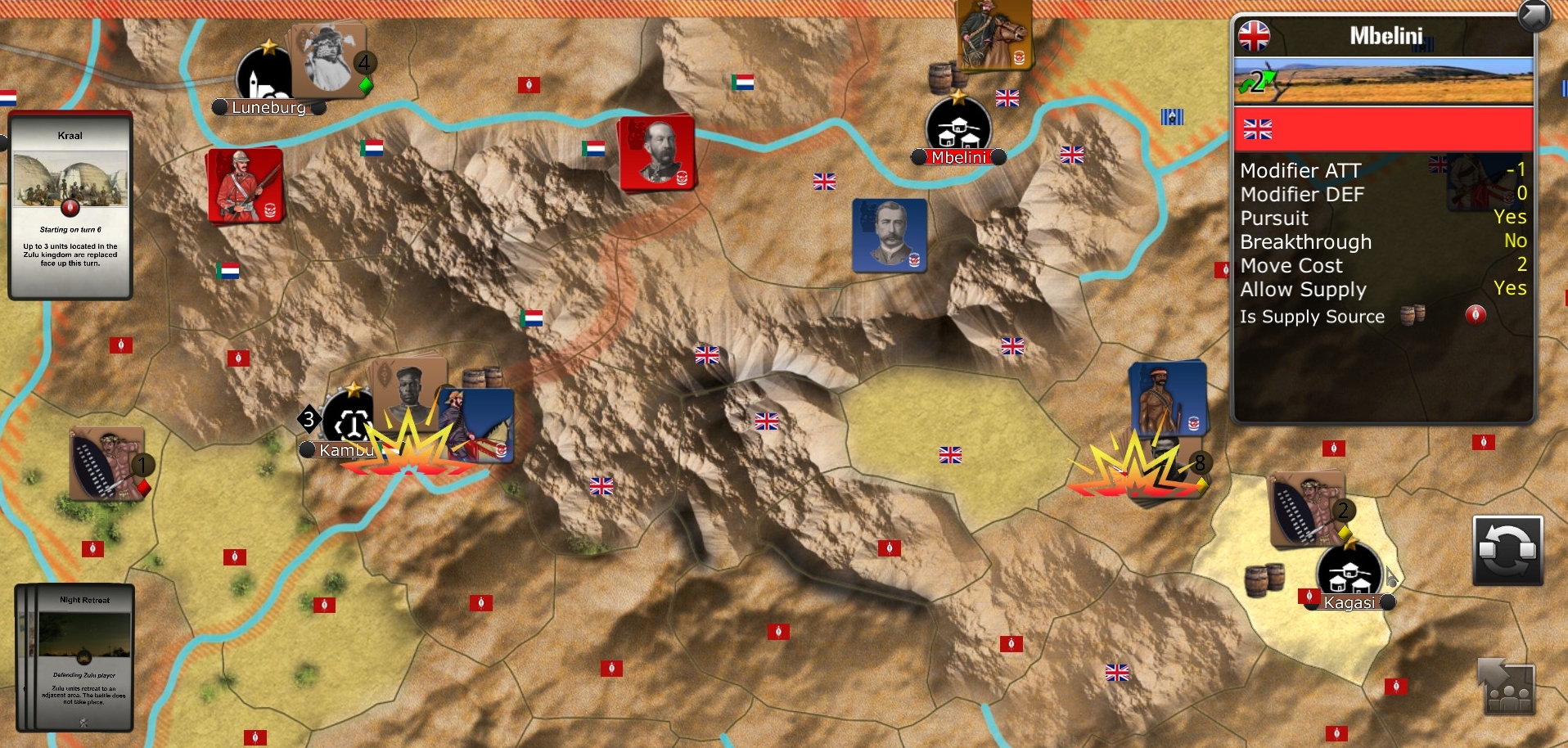
When the veteran WATW warrior sits down for a spot of Strategiae’s staggeringly versatile TBS, they know, deep down, defeat is unlikely. A combination of reversible scenarios (all DLCs contain a single scenario playable from both sides) and an AI that seldom guards its supply lines and most valuable VLs as assiduously as it should, means player victories, even on ‘expert’ difficulty, are usually not hard to come by once you get a feel for things.
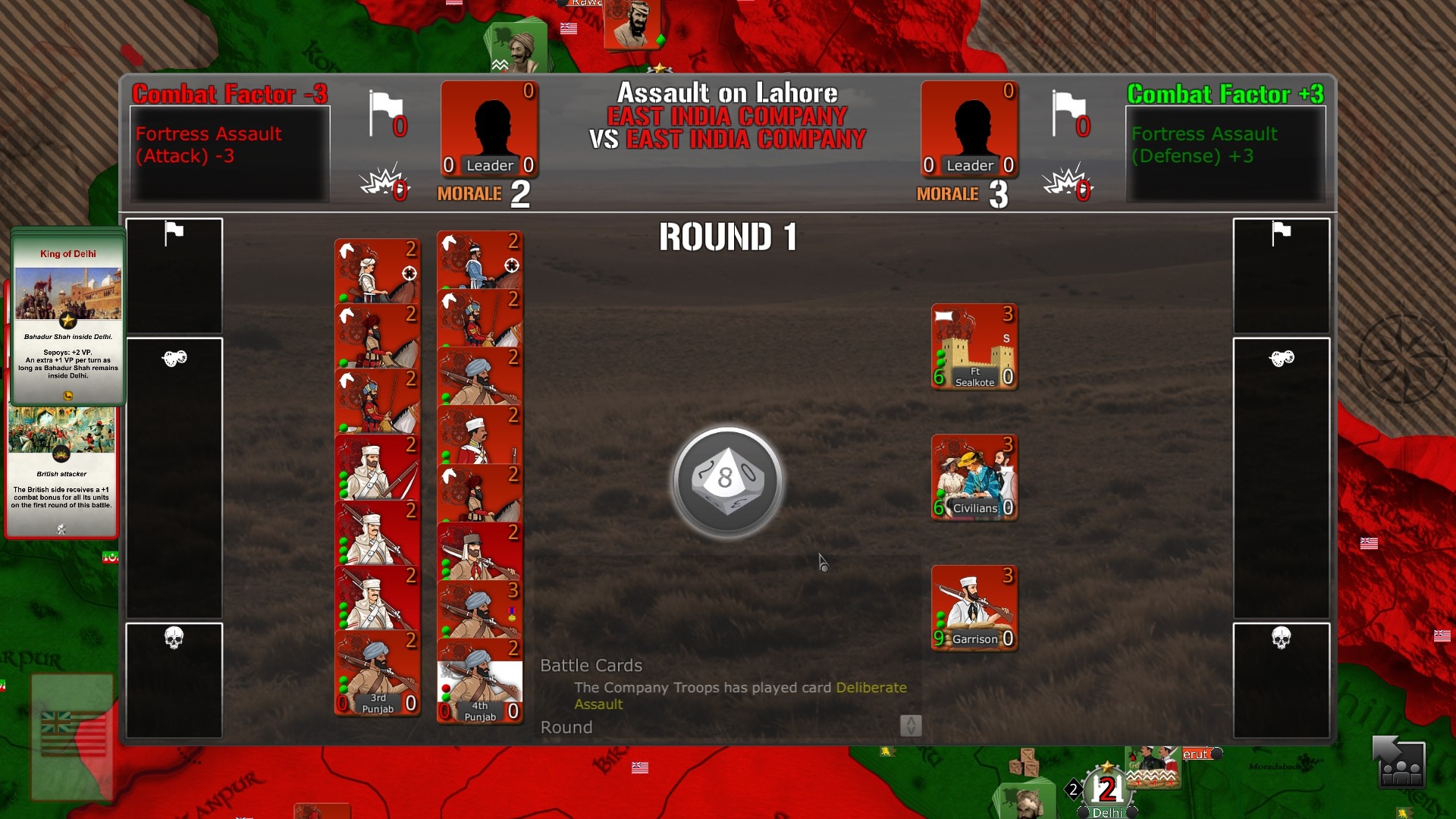
While UI quirks like the need to plot movement with care are soon forgotten, the minor bugs* that dot many of the add-ons have the potential to aggravate both the green and the grizzled. Typos, occasional freezes** and faulty cards… few of the DLCs are entirely flaw free.
* The image above shows forces belonging to the East India Company inexplicably assaulting one of their own cities!
** Generally these can be circumvented by quitting and loading the last autosave.
And yet, because WATW goes places where few other wargames dare to venture, is rarely dull or unattractive, and suits impatient strategists down to the ground, I seldom stay away for long. Lured back by the clatter of iklwas on Nguni shields, this week I’ve been bingeing on the game’s four redcoat-rammed adjuncts.
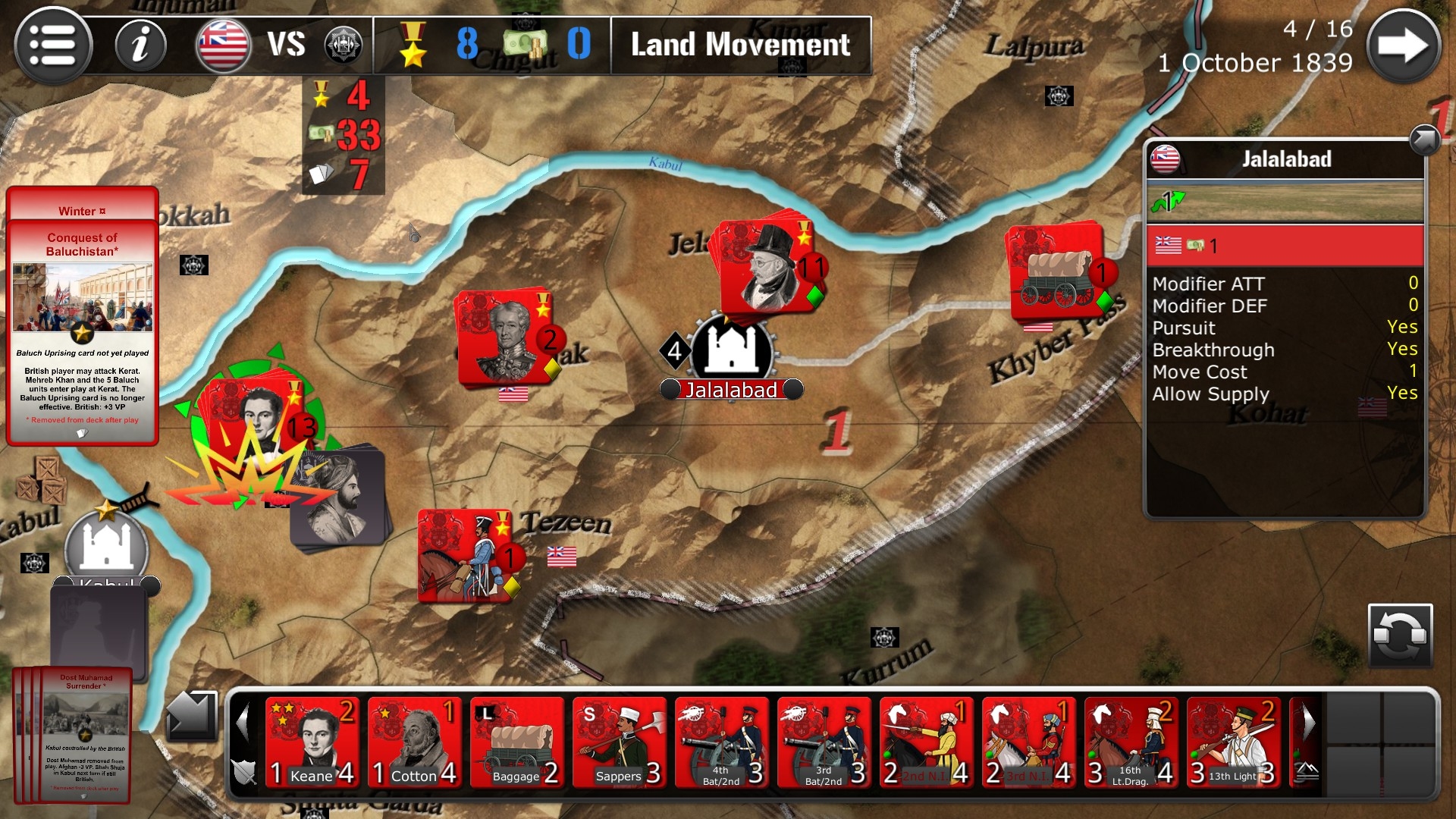
The first of those adjuncts, chronologically and alphabetically speaking, is Gandamak 1842, a cheap, low-headcount offering that turns one of the UK’s most senseless and calamitous Nineteenth Century military adventures into a short*, sixteen-turn screen struggle.
* Circa one hour.
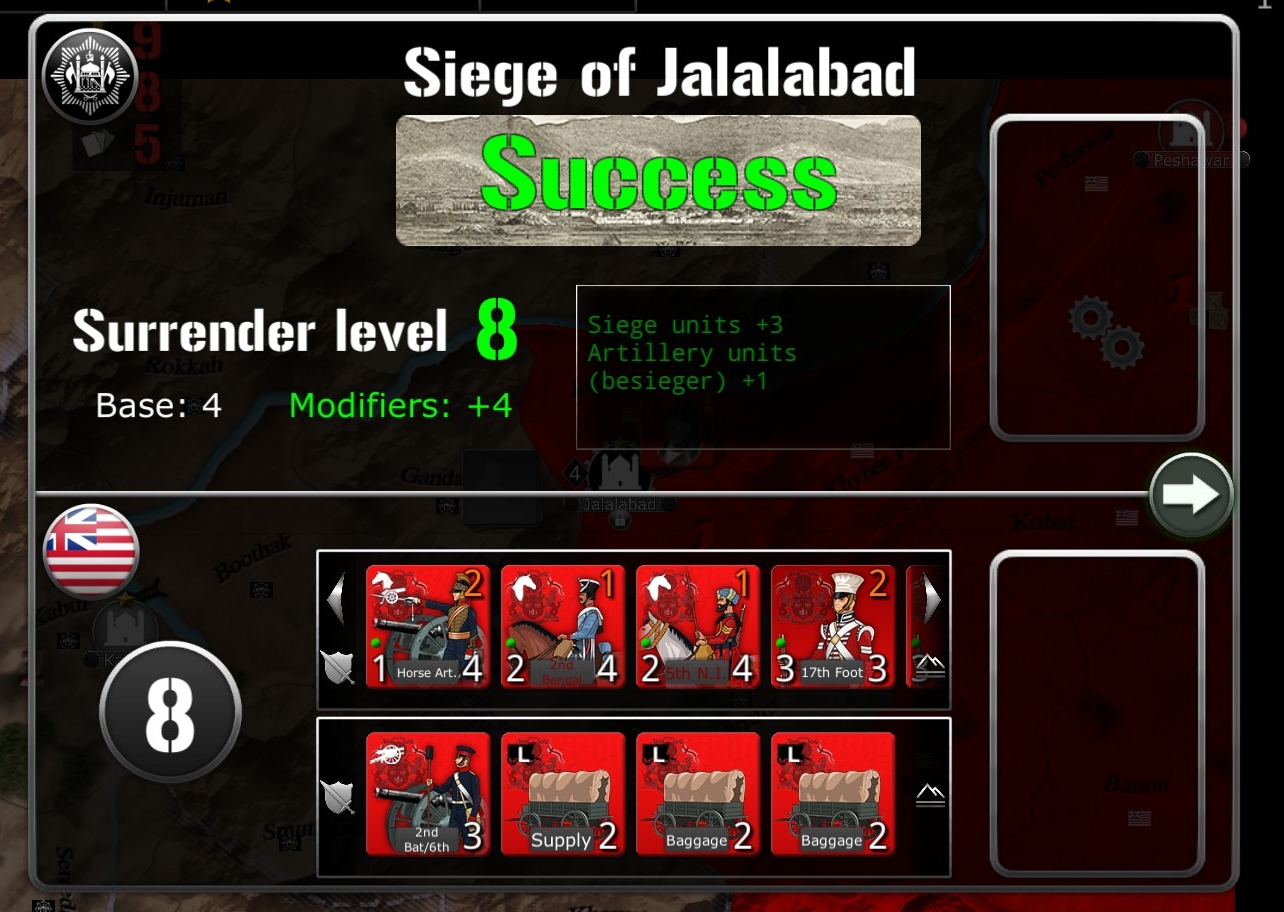
Playing as the Afghans in the First Anglo-Afghan War, you’re out to slay as many firangi as possible, and retain Kabul and, ideally, three other cities too. Click the striped ensign of the East India Company on the start screen, and your primary goal is taking the capital in order to install your poorly chosen puppet, Shuja Shah.
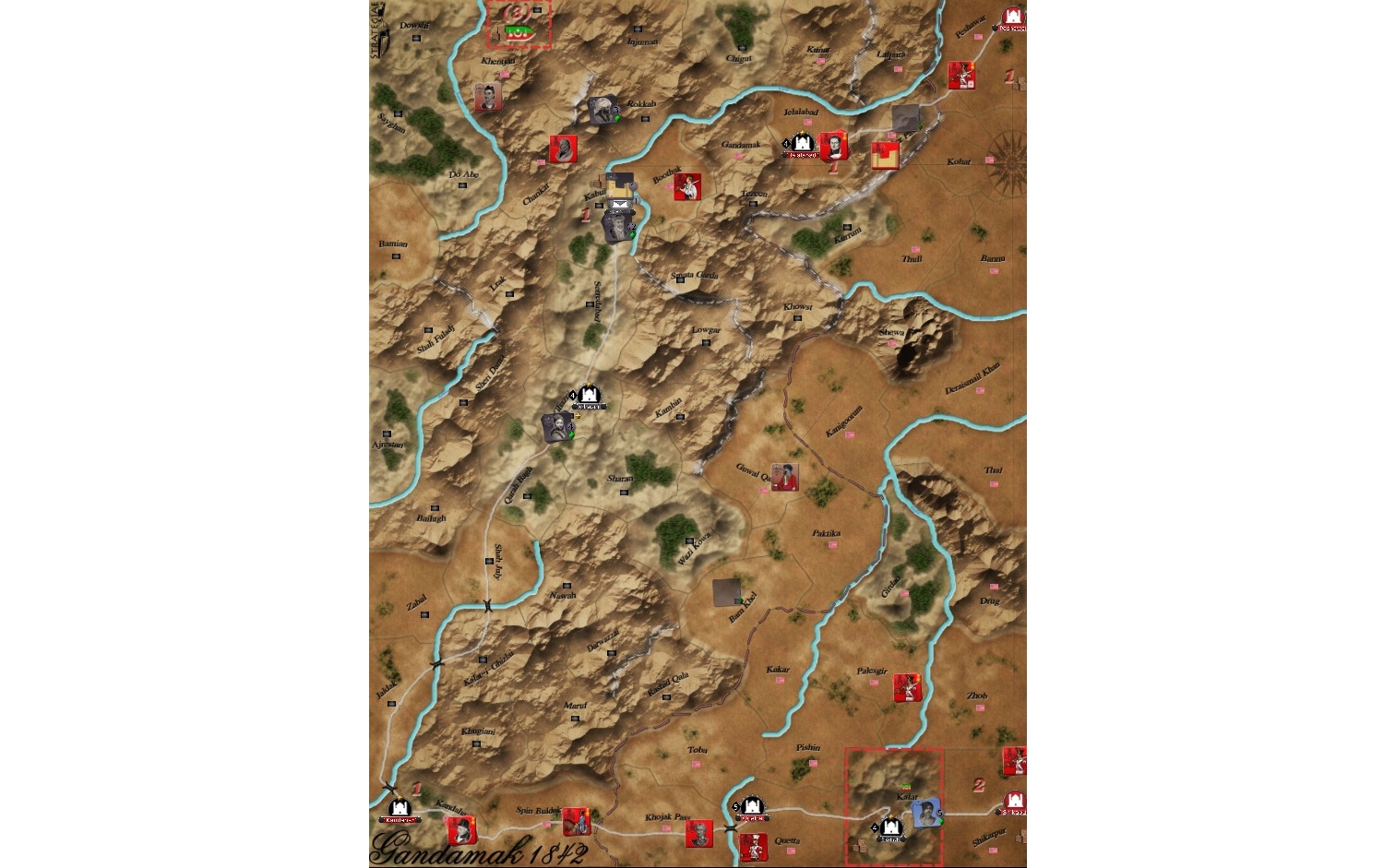
In theory, elusive tribesman, a small, extremely rugged map, and late-game cards that attempt to prod the British player into organising a risky withdrawal, make things tricky for the EIC. However, experienced WATWists should be able to avoid Elphinstone’s mistakes with little difficulty.
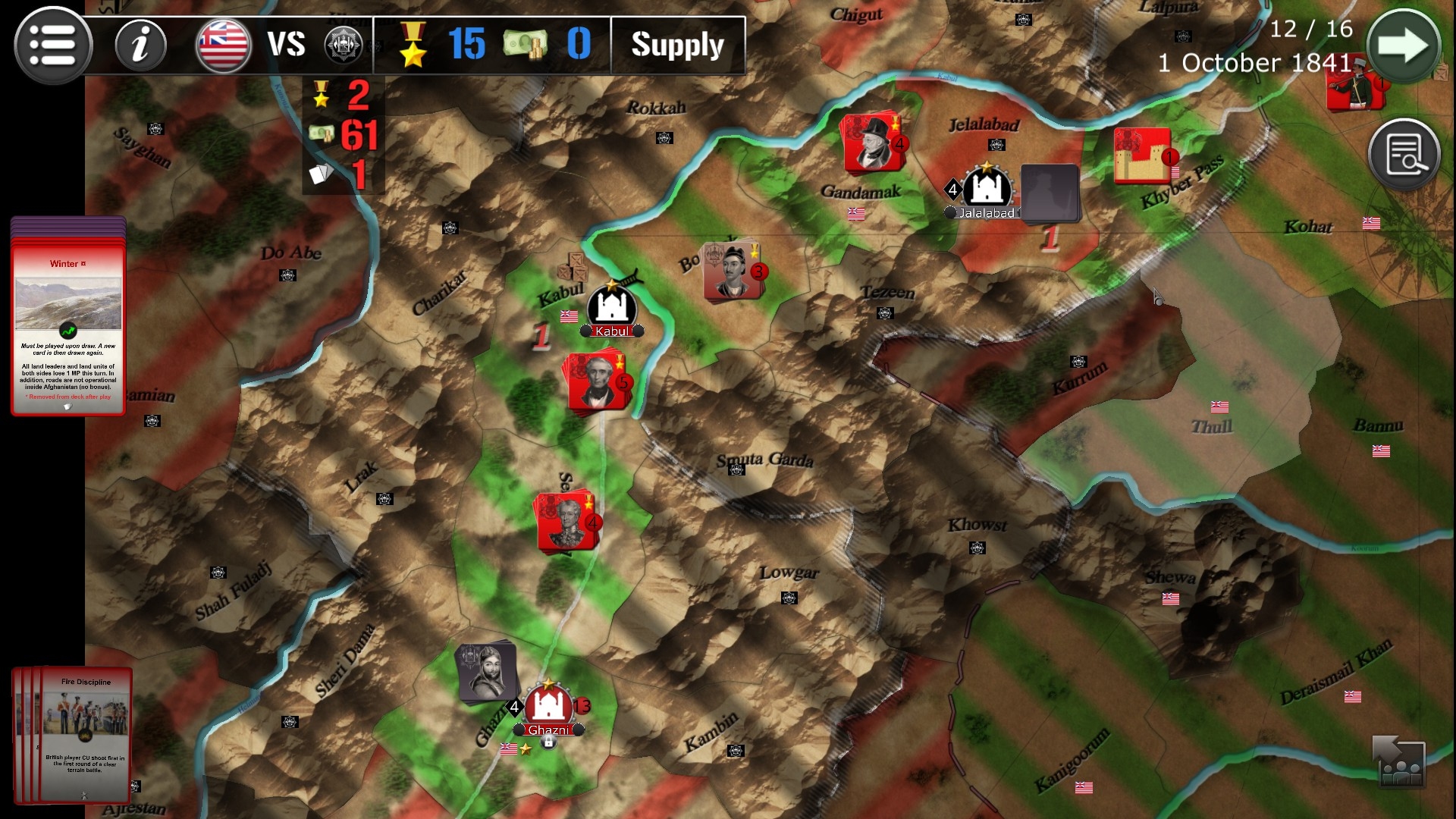
Although every time I’ve played as the locals, the redcoats have failed to secure sufficient Victory Points for a win, I’ve had a number of alarming setbacks and a few close shaves.
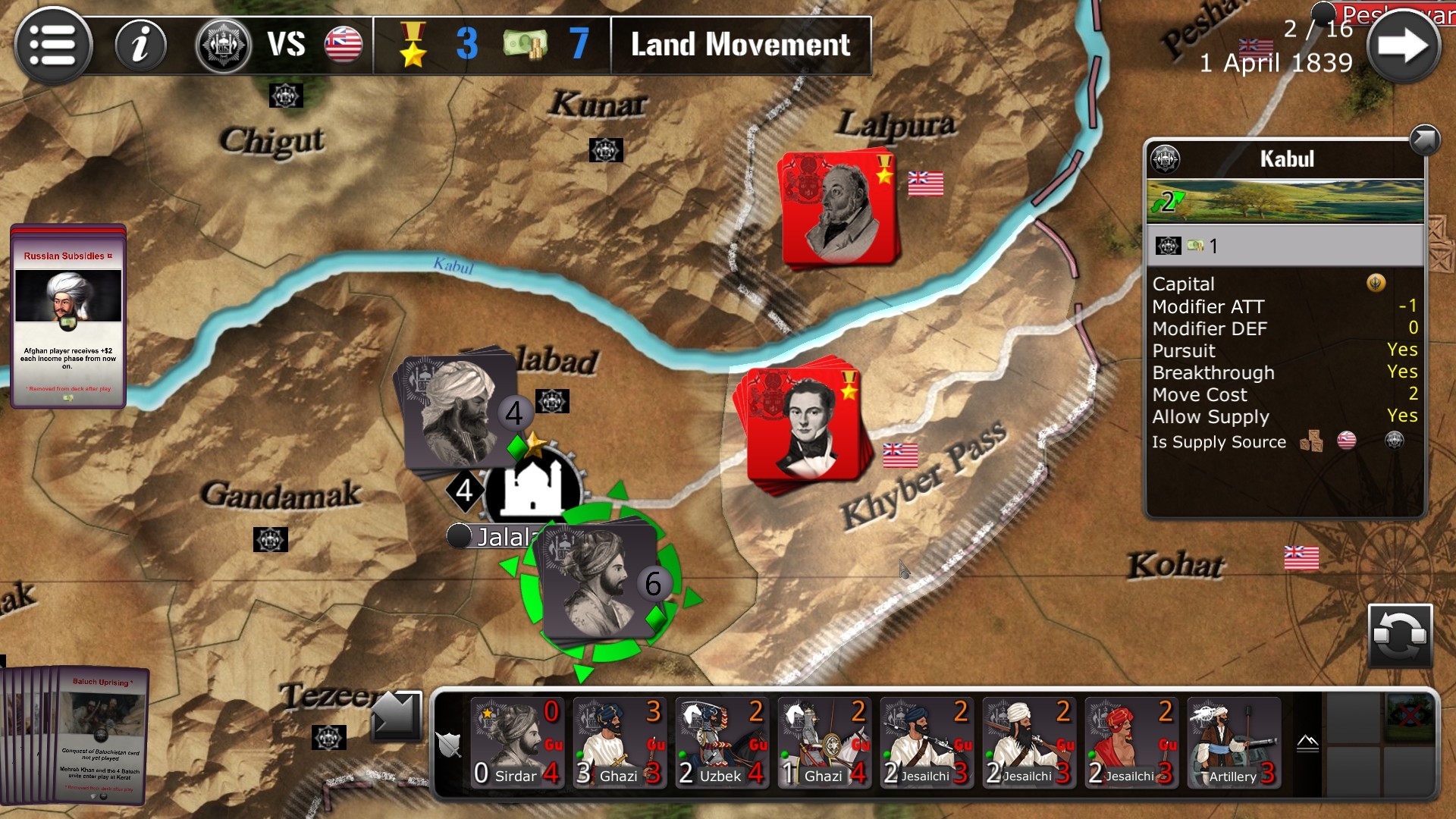
As ever, an unpredictable AI and a thick deck of colourful event cards encourages replay. Winter weather… Russian financial aid… (unlike some DLCs, this one features unit and card purchasing)… dramatic developments like the killing of Alexander Burnes and the dispatch of the Army of Retribution… they’re all fully or partially card triggered. Gandamak 1842 might not be a truly great ‘Great Game’ game, but it’s an entertaining introduction to the subject, and a fine way to begin a WATW colonial bender.
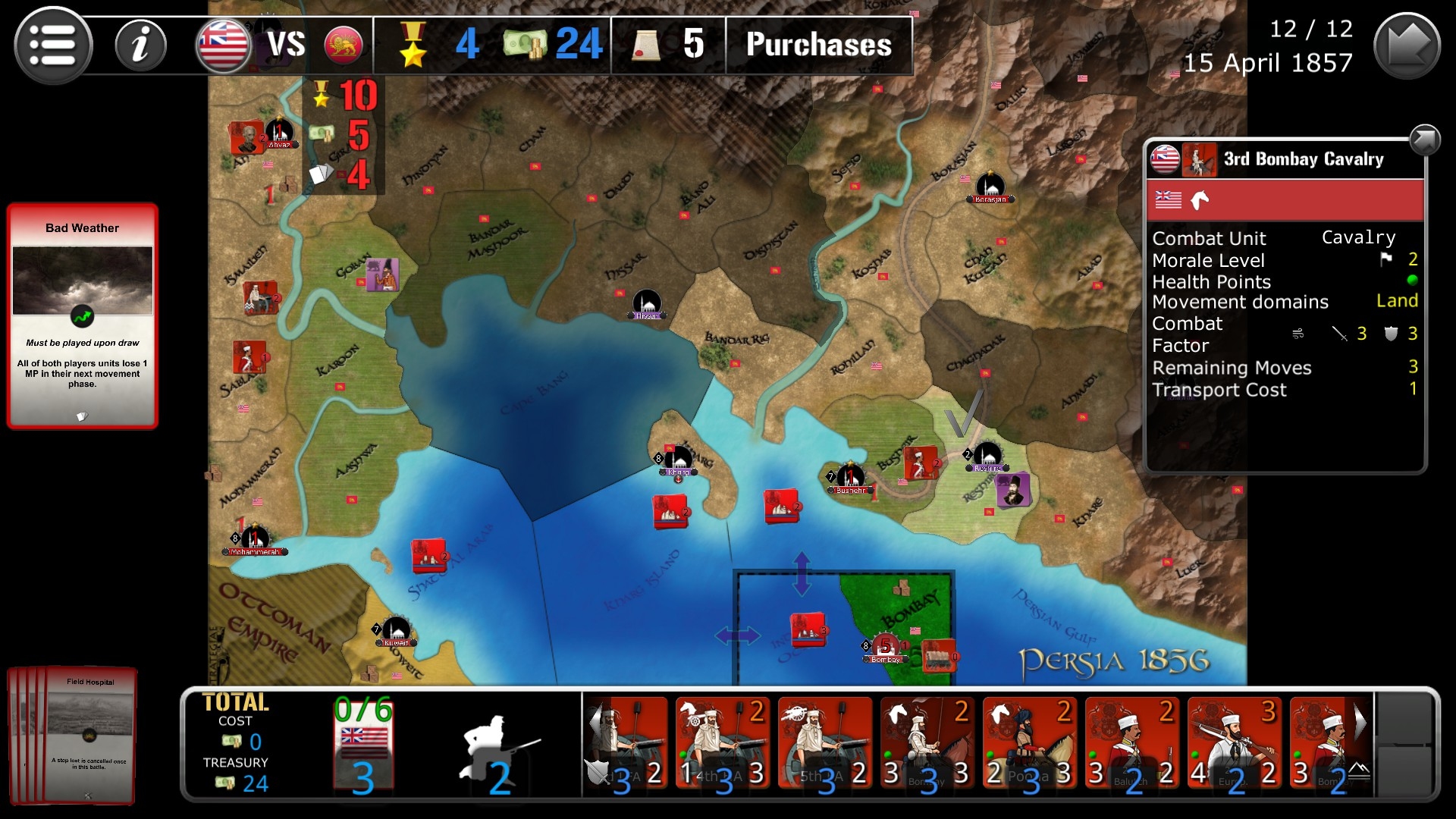
In a sense Persia 1856 is an Afghanistan focused title too. Even more bijou than Gandamak, this two-quid, twelve-turn, fifty-province DLC aims to precis the Anglo-Persian War. In late 1856, angered by Iran’s treaty-breaking capture of the semi-independent Afghan city of Herat, Britain landed troops close to the gulf port of Bushehr. John Bull’s goal – to bring Iran to heel by trouncing her army and occupying a few of her settlements – is fairly faithfully replicated in the scenario’s victory conditions, and, somewhat surprisingly given the history and WATW’s track record of facileness, is actually a pretty big ask in-game.
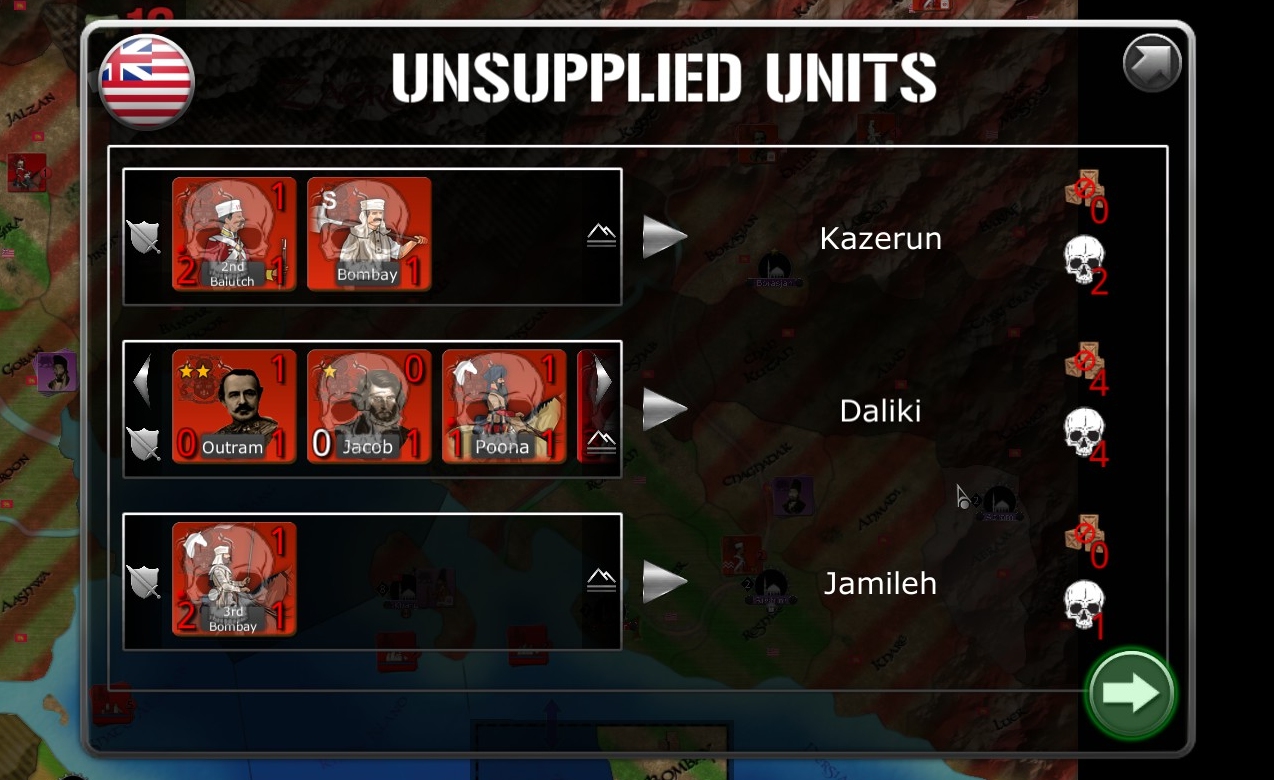
My first invasion bid started promisingly but disintegrated after the AI, tired, no doubt, of listening to me denigrate its logistical abilities, decided to teach me a lesson by deftly separating the bulk of my forces from their supply hub. Suitably chastened, I was much more cautious during my second attempt. Too cautious, it turned out – that one ended in failure too.
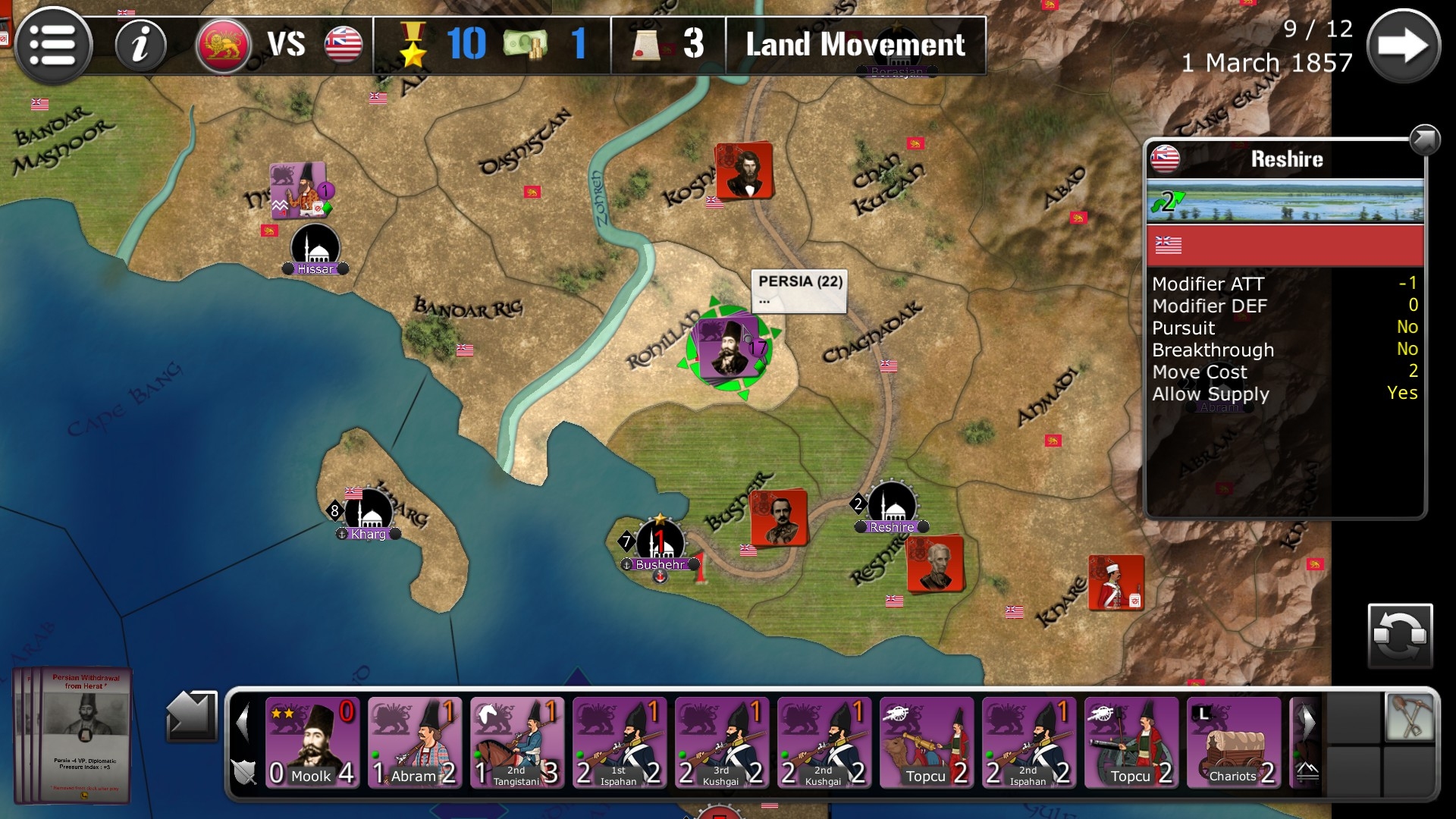
The claim on the Steam page that the task facing the Iranians is even tougher than the one facing the Brits, should be true, but isn’t. I’d advise easily dispirited newcomers to play the defenders first.
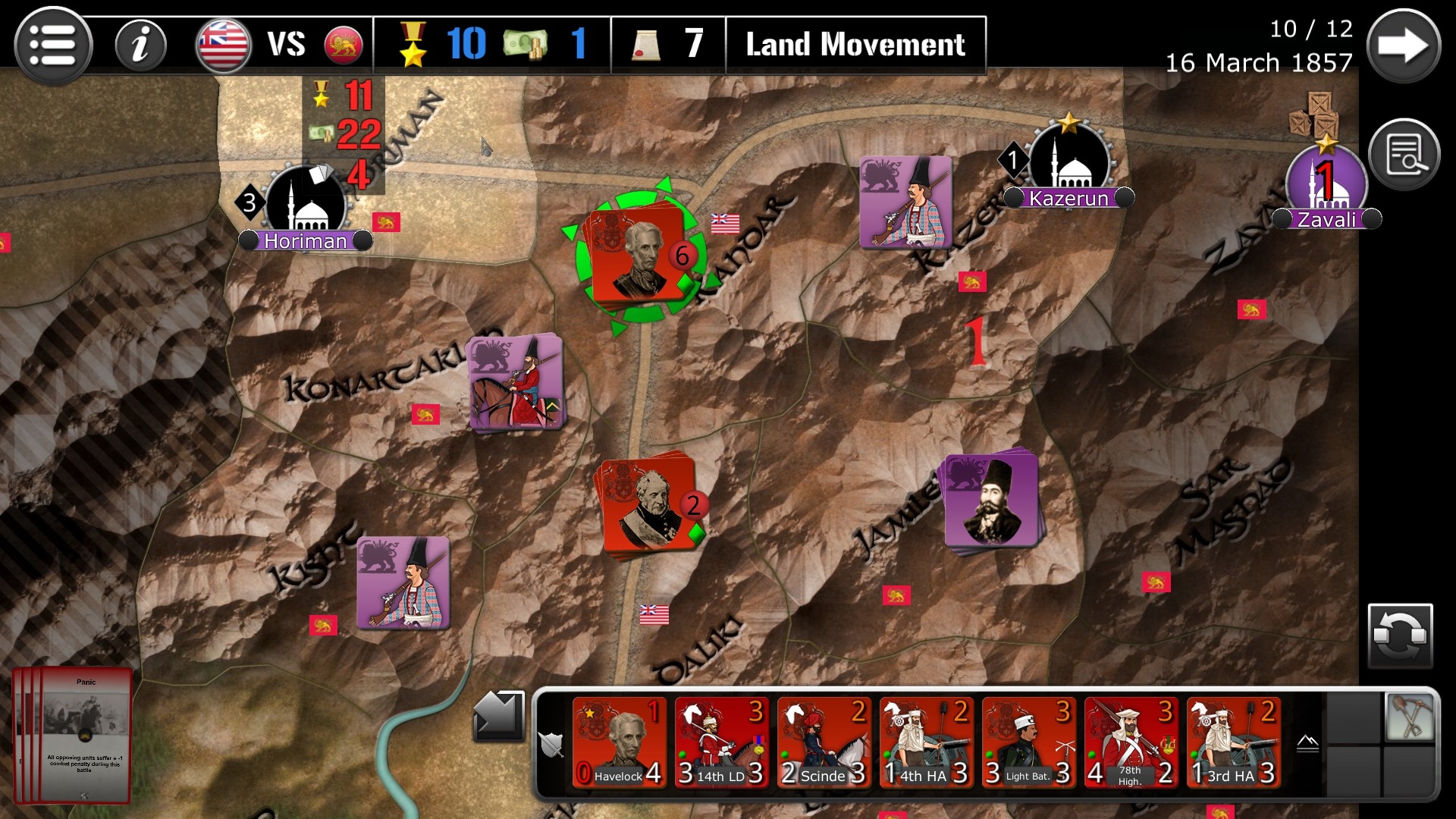
A dash of naval transportation, coastal battery suppression, and political pondering (Playing certain cards impacts a Diplomatic Tension index, that can, if left unchecked, bring the invasion to a Suez Crisis-style premature end), add interest to one of WATW’s briefest and toughest supplements.
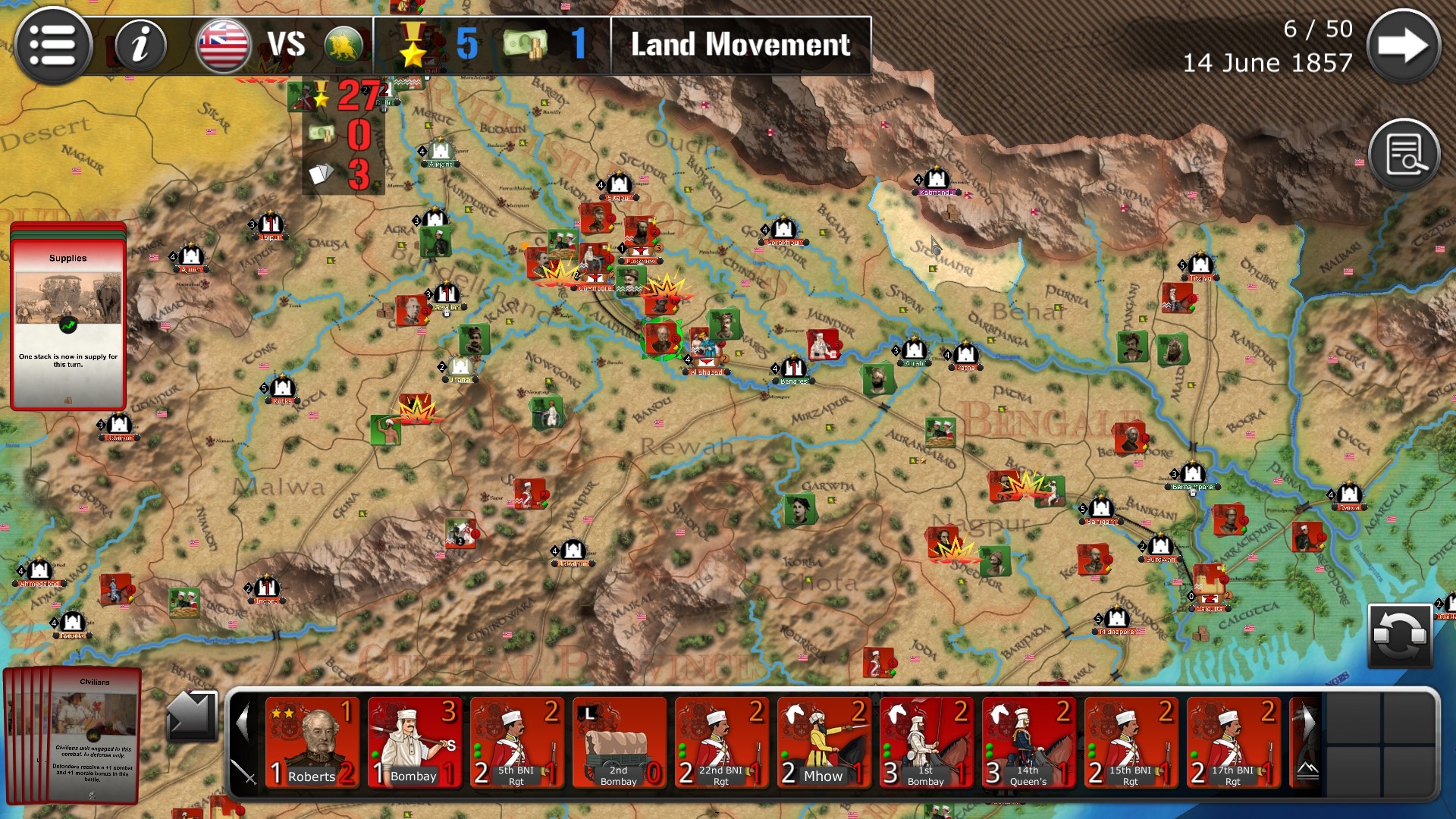
By the time James Outram, the commander of the Persian expedition, made it back to India with his ten thousand men, significant portions of the country were in the grip of the revolt often referred to in Britain as the Indian Mutiny. As its relatively high price indicates, Sepoy 1857 is one of WATW’s largest, longest*, and most populous adjuncts. I wish I could say it was also one of the best, but sadly I can’t. After an extremely promising start, familiar demons show up and spoil the fun.
* 50 one-week turns.
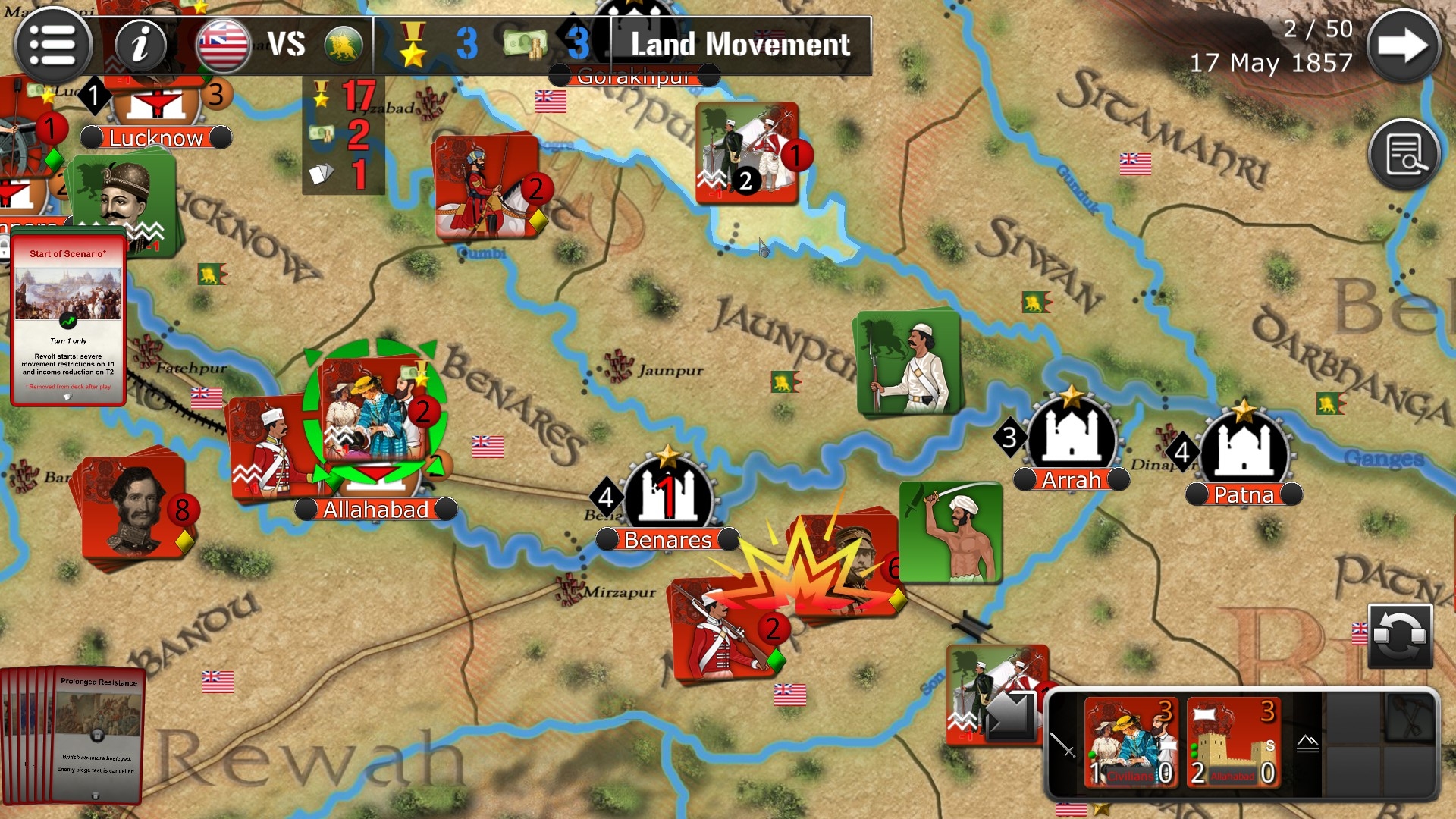
That start is particularly exciting if you opt to play as the EIC. Besieged in cities such as Lucknow and Cawnpore, and outnumbered by febrile rebel forces that grow in strength thanks to card-triggered defections, the Brits find themselves in what appears to be a hopeless situation. Surveying the vast threat-dotted map at the end of turn one on my first playthrough, if anyone had told me I’d be confident of victory just seven or eight turns later, I’d have scoffed. However, that was exactly how things transpired.
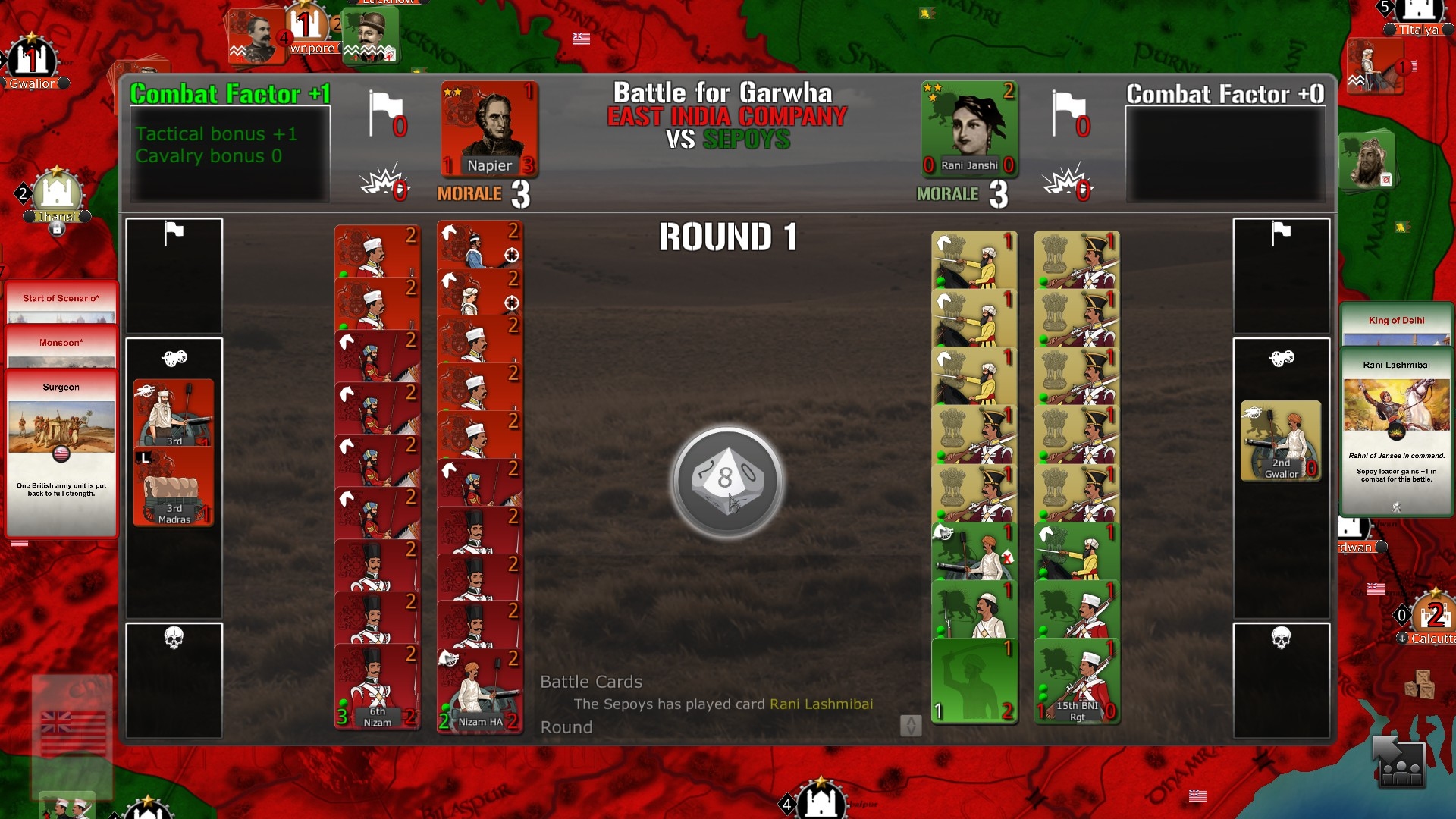
By picking fights carefully, fortifying or combining forces too feeble to go on the offensive, and using cavalry to snip supply lines, I swiftly gained the upper hand. By the time the Afghans launched a doomed invasion circa turn 14, the map was almost entirely red. For the last two thirds of the game, I had little to do except periodically dispatch assets to eliminate randomly generated bands of badmashes.
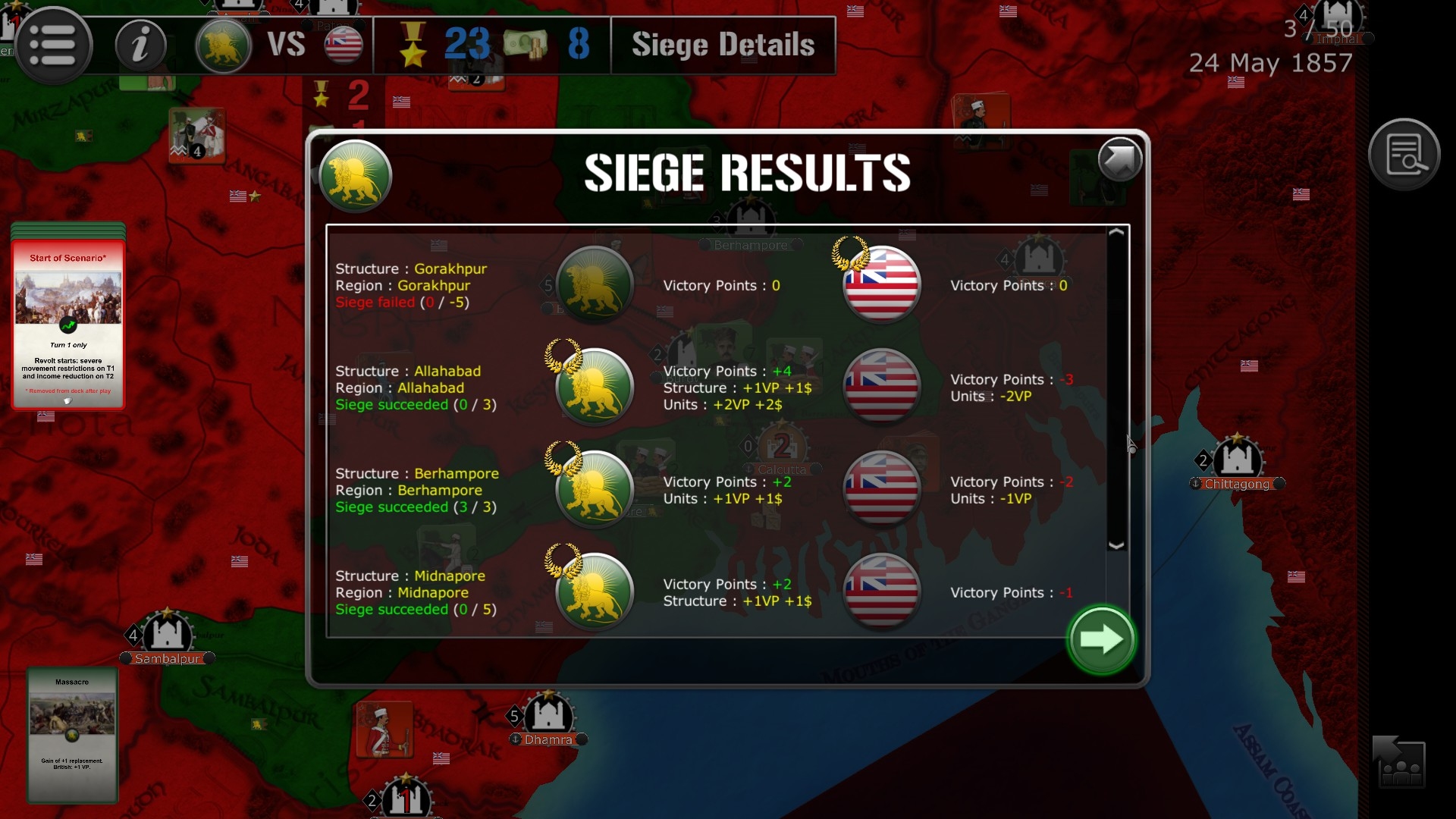
Improbably, guiding the rebels to victory proved even easier. Just nine turns into my initial insurrection attempt, a screen popped up announcing that I’d accumulated sufficient VPs to earn instant victory. Once again, I’d won the day with a mix of wary battling, energetic province snatching, and supply line disruption.
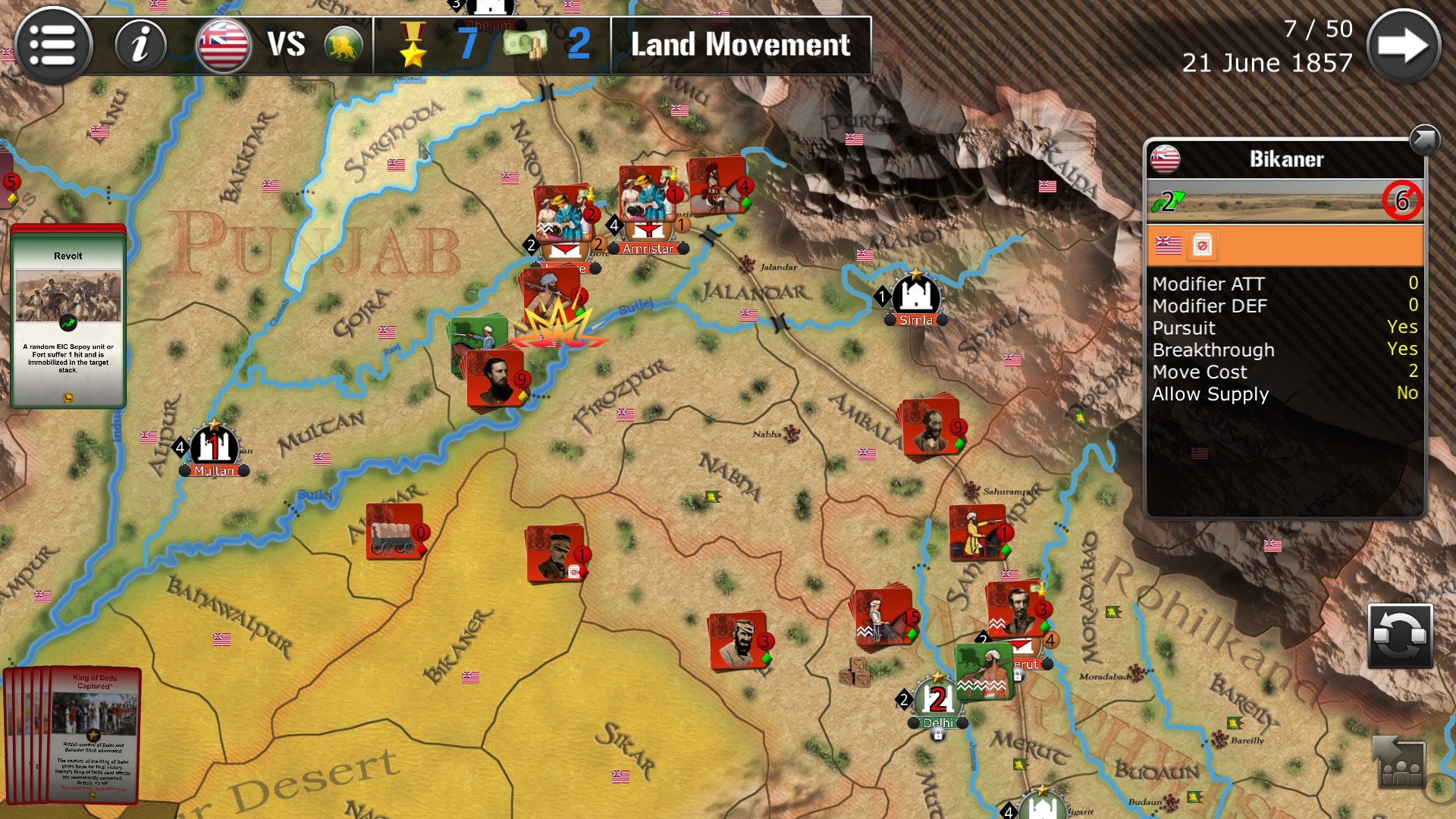
Given the amount of work that has obviously gone into the map, cards, and counters, and the beautiful way Sepoy conveys both the chaos of the Mutiny’s early stages and the stubbornness of the defenders at besieged locations like Lucknow (Special cards and bonuses allow certain surrounded cities to survive much longer than they would in a standard WATW scenario) the lack of challenge is a big disappointment.
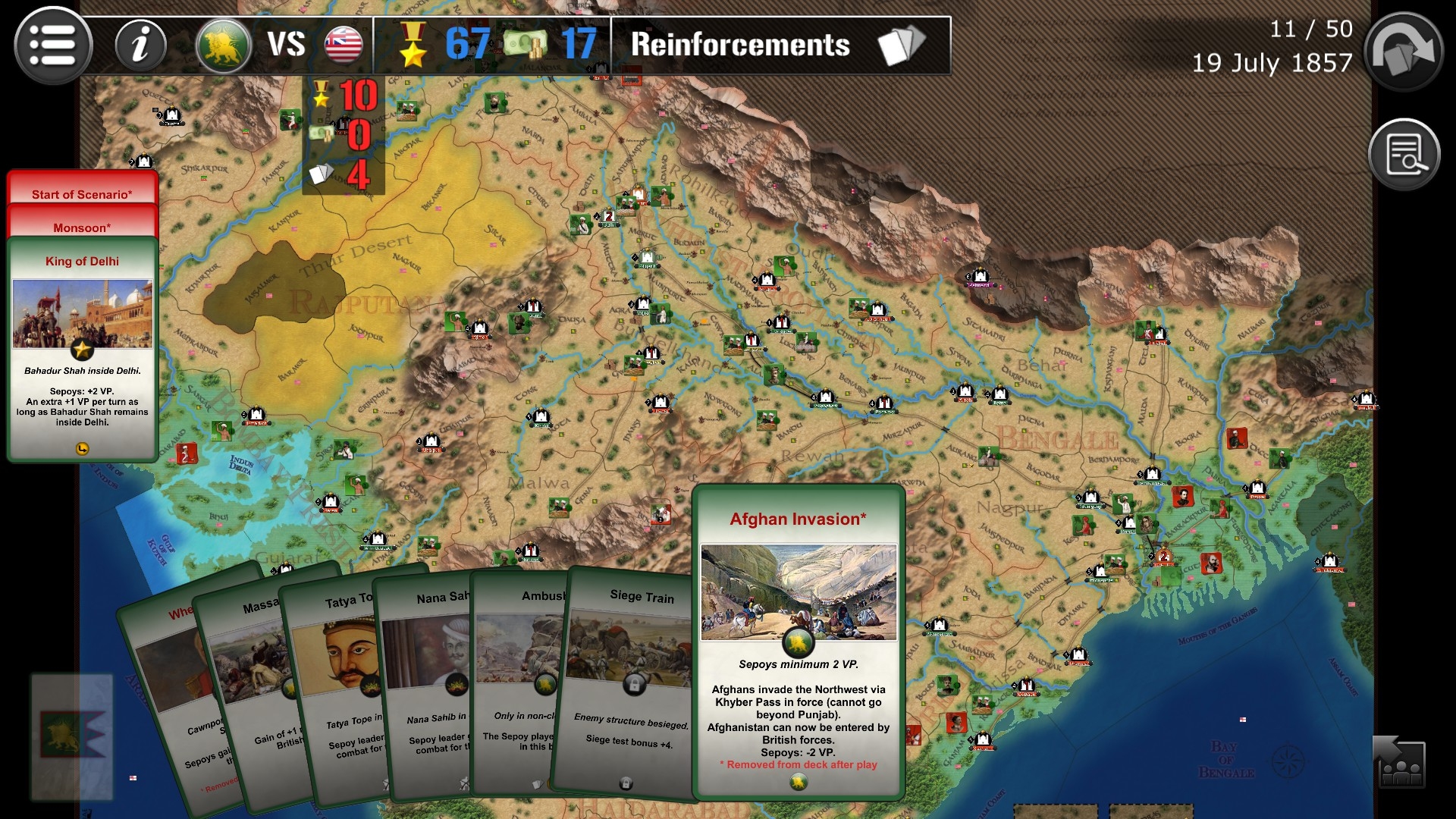
Strategiae, surely there has to be a way to harden creations like this one? New victory conditions? Limited leader activations? One of the reasons the uprising failed was there was little coordination between the various rebel armies… no-one in overall command. Forcing players to pick which chit stacks they wished to use each turn would be one way to shorthand this lack of coordination.
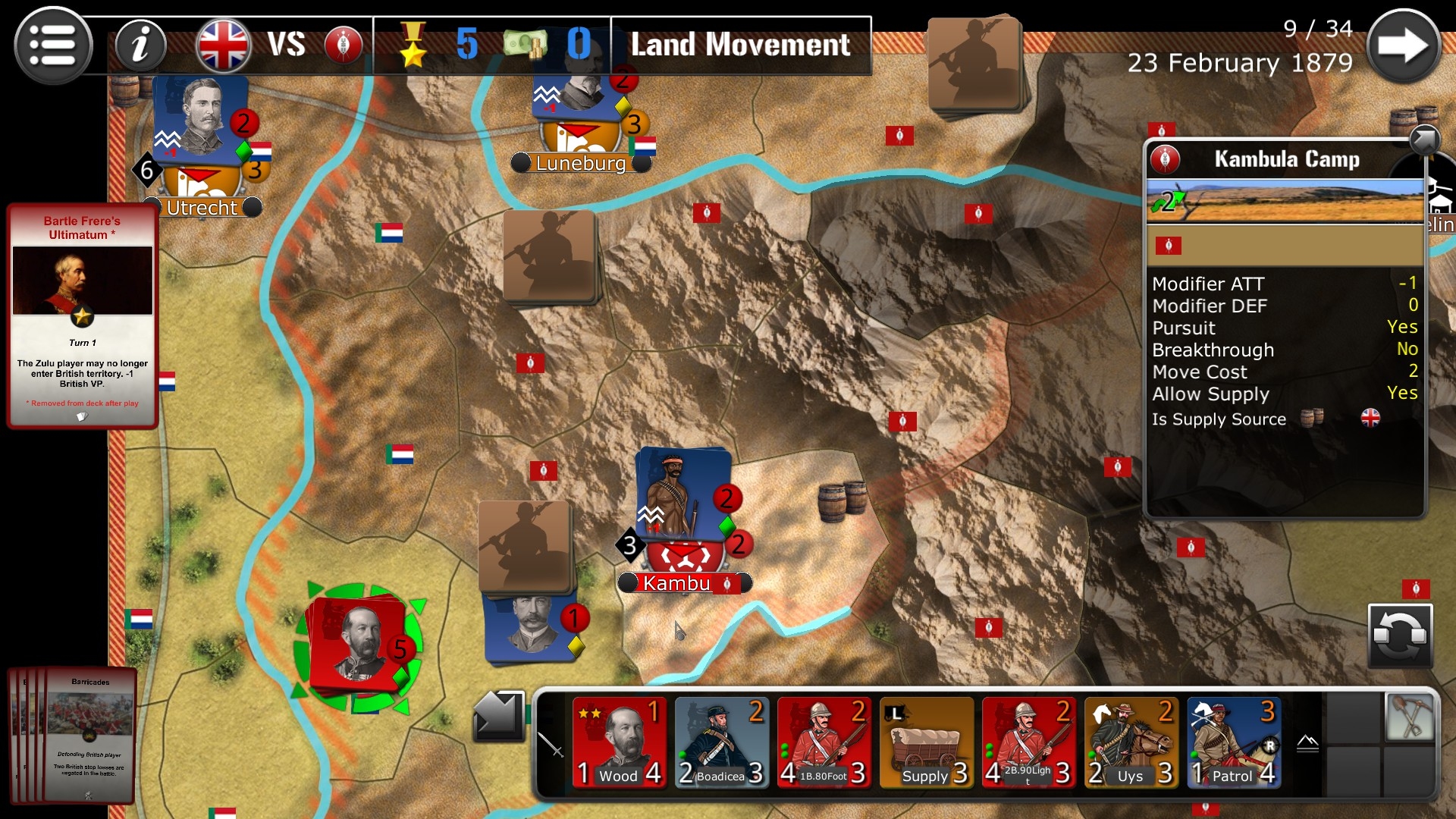
Lord Chelmsford and Evelyn Wood, two of the most useful red counters in the thirty-four turn Zulu 1879, were plucky participants in the Indian Mutiny. Although Chelmsford didn’t exactly cover himself in glory in the Anglo-Zulu War, in this enjoyable £4 re-run he gets plenty of chances to redeem himself.
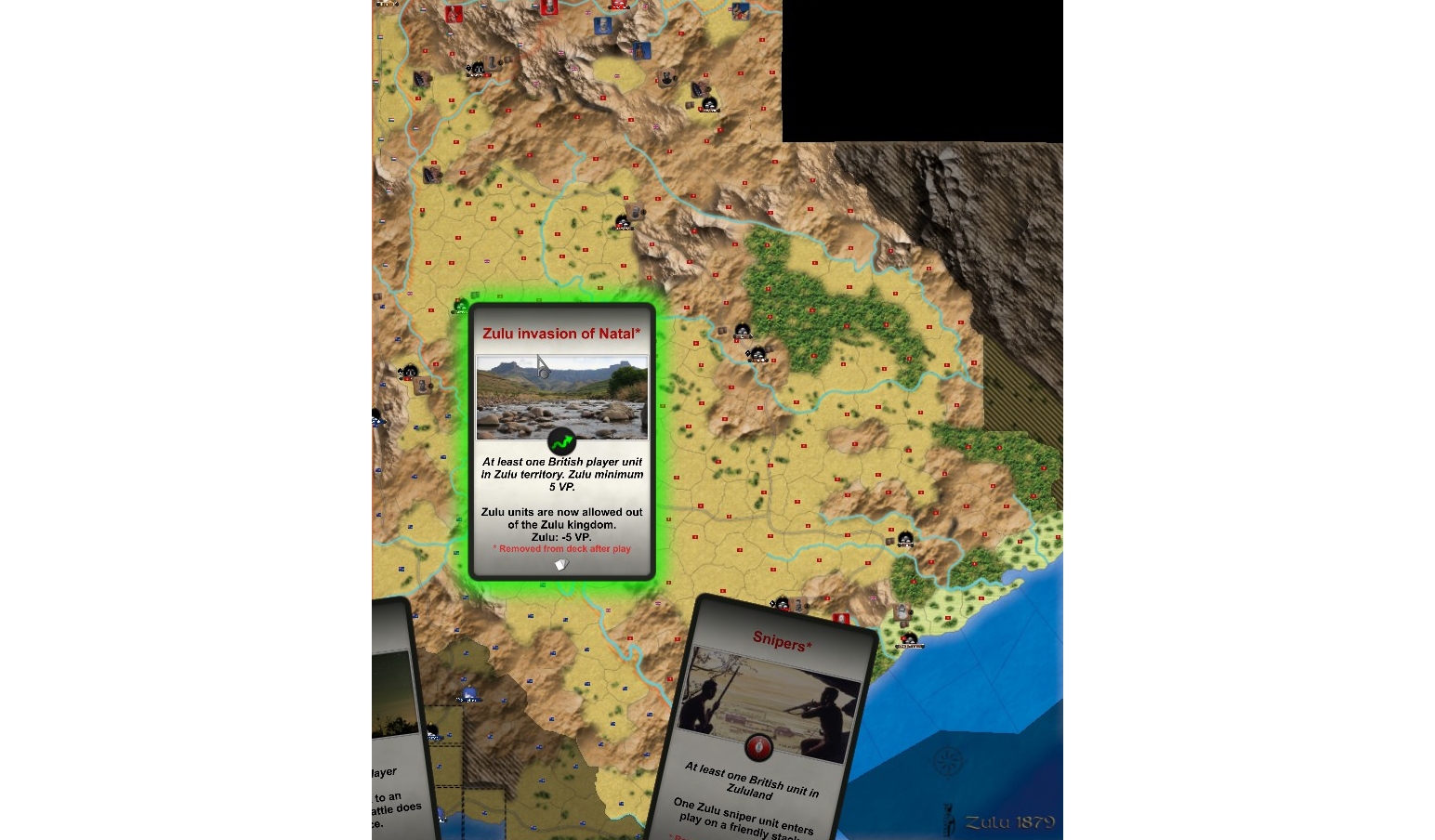
Briefing descriptions of highly mobile Zulu forces immune to supply strangulation, inspire confidence in the design and respect for Cetshwayo’s forces at the outset. Leading the three-pronged unprovoked and unsanctioned* invasion of Zululand for the first time, it wasn’t long before I’d inadvertently engineered my own version of the Battle of Isandlwana.
* High Commissioner for Southern Africa, Henry Bartle Frere launched the war without consulting London.
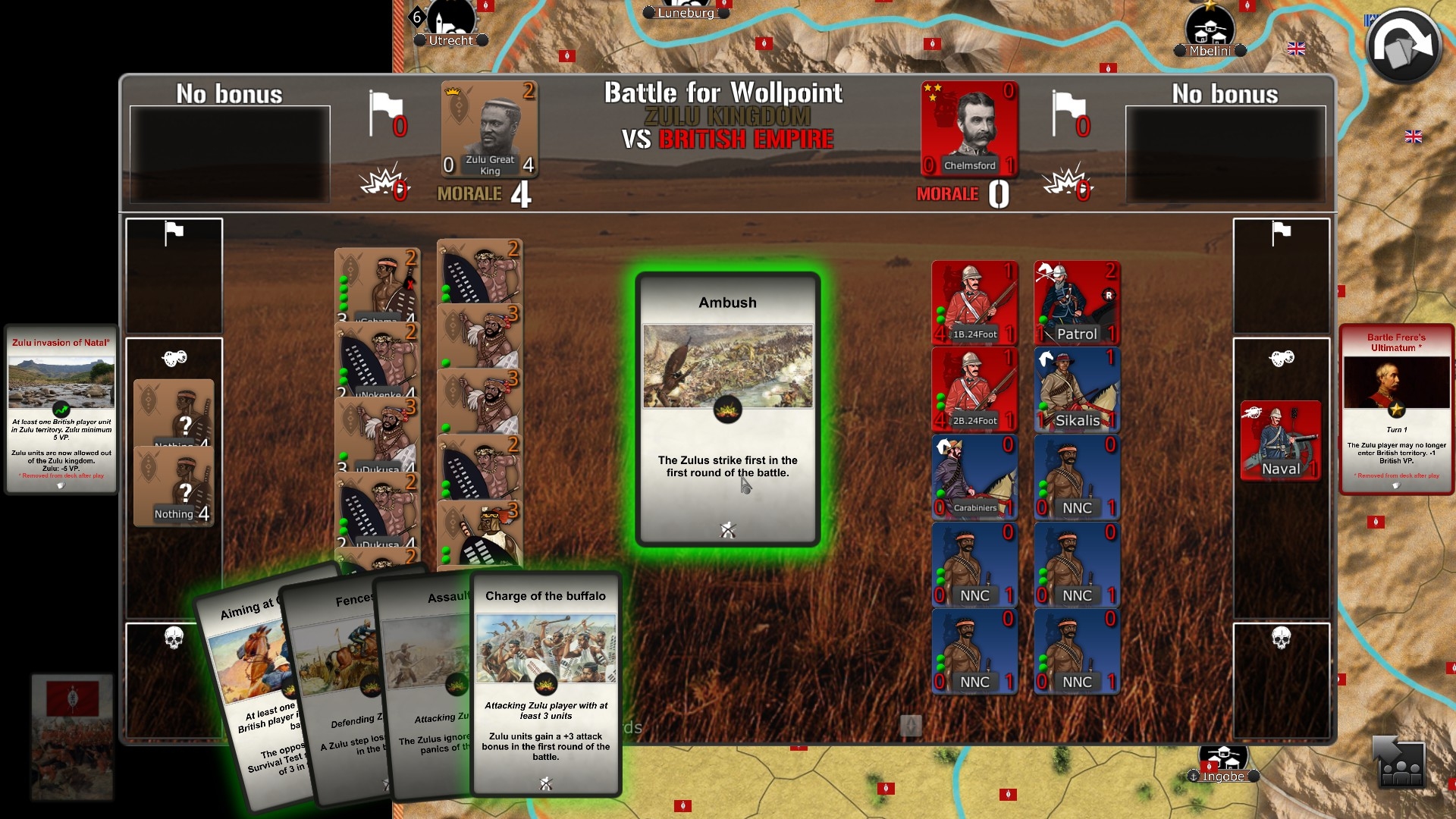
Sizeable Zulu armies in possession of powerful combat cards like ‘Charge of the buffalo’ and ‘Swallow trap’ almost guarantee early clashes are costly for the redcoats. However, in the pleasingly evocative manoeuvres and battles that followed my setback, my opponent proved he wasn’t wholly reliant on buffs to foil plans. More than once I found myself inspecting a knot of British units enervated by an ingenious bit of interdiction or an unexpected attack.
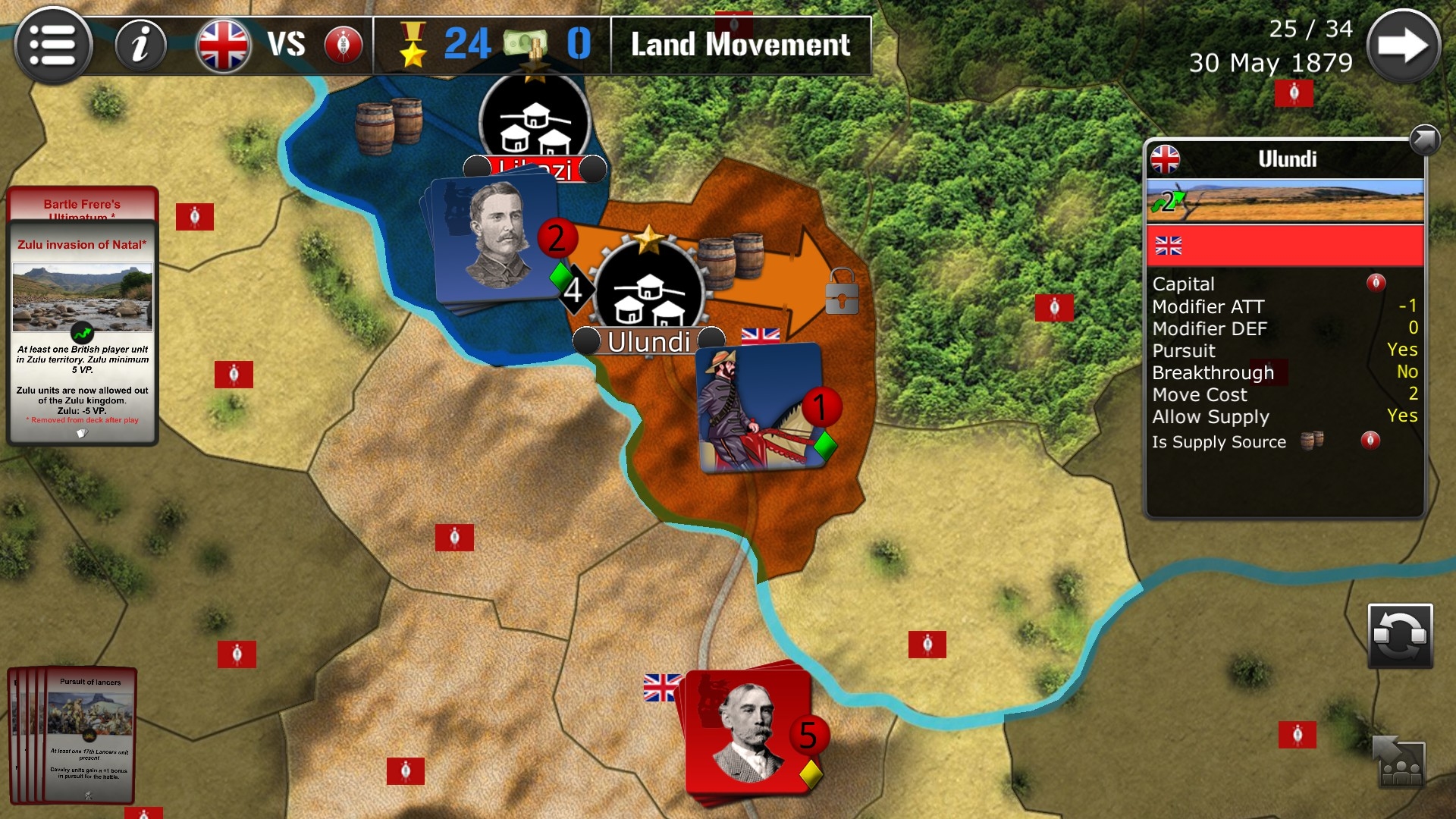
Yes, I took Ulundi, the enemy’s capital on turn fifteen, effectively ending the game (it is possible to continue after victory conditions have been met), but Cetshwayo and Co. had made me work for my triumph.
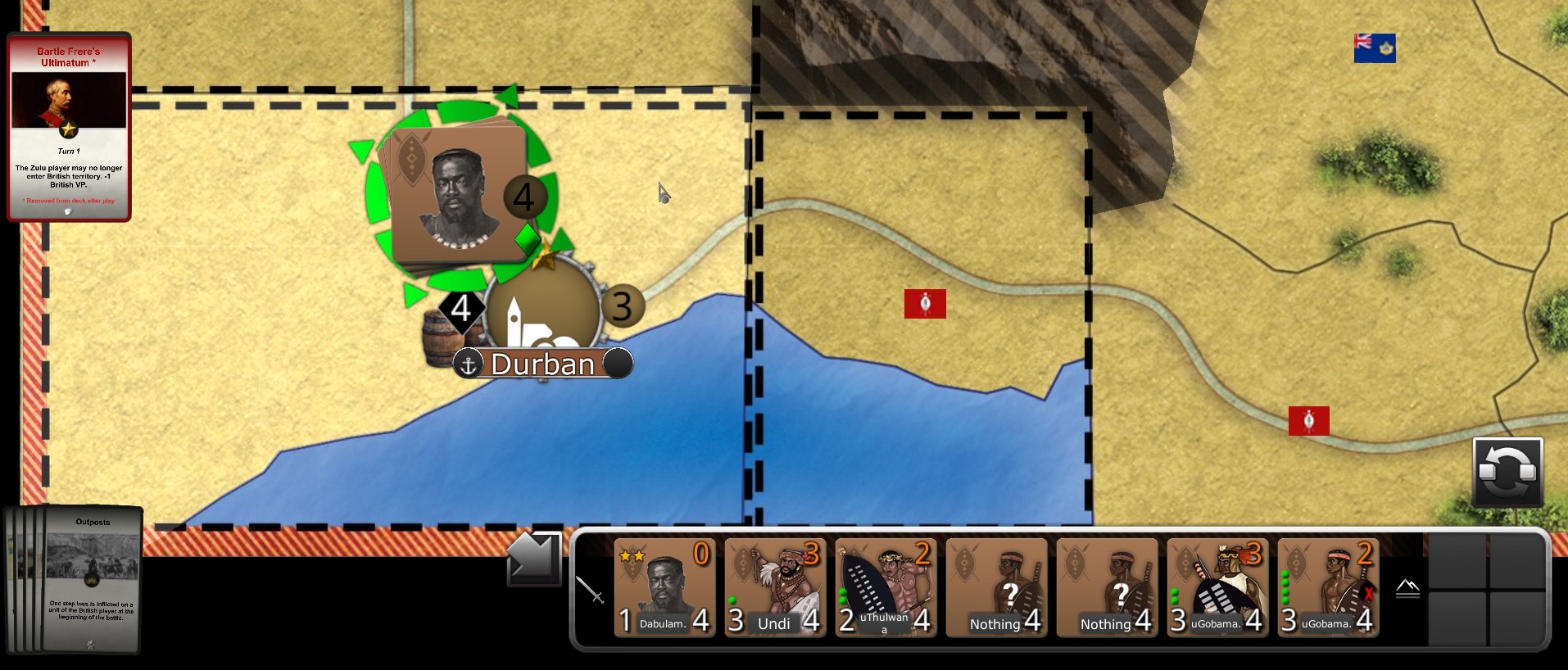
The Zulus behaved quite differently during games two and three. While both playthroughs ended with British troops encamped at Ulundi, the road to victory was longer and strewn with more bloody pith helmets. If the rules writers had chosen to penalise the loss of Durban more harshly (the Zulus need to take Durban, Pietermaritzburg, and Utrecht, in order to achieve an instant victory) I might have tasted defeat.
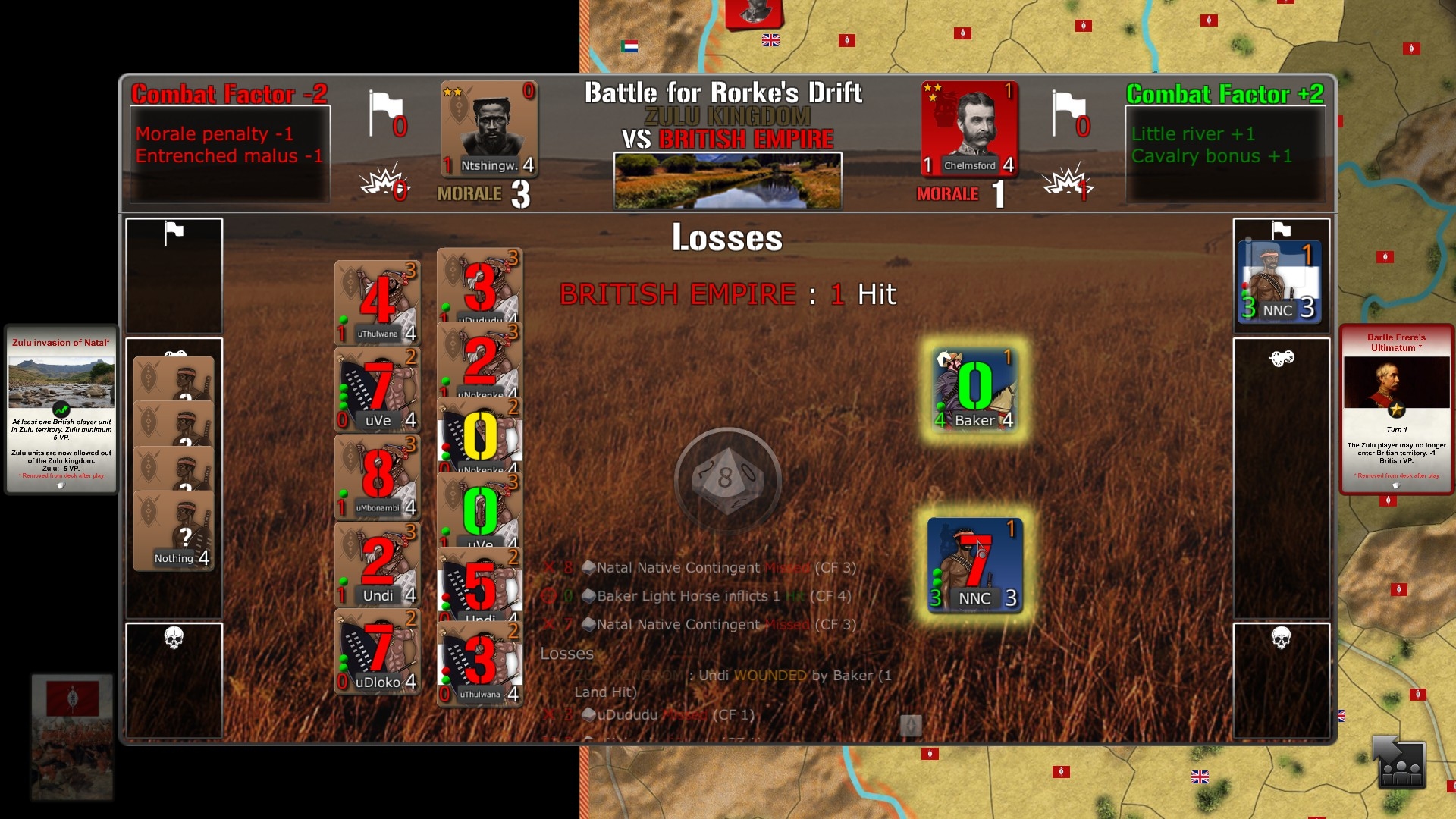
After a morning choreographing the ‘swallows’, I switched sides and spent the afternoon happily collecting Victory Points with the help of leaders such as Mnyamana Buthelezi and Mbilini waMswati. However deep your love for Zulu, however unwavering your loyalty to Queen King and Country, it’s impossible not to be thrilled the first time you take Rorke’s Drift or completely annihilate Chelmsford’s column. Thanks largely to the spacious map and the long supply lines it necessitates, I found wins came slightly easier when impelling impis.

Zulu 1879 joins the long list of WATW DLCs that are too vincible for their own good, but I don’t regret in the slightest the day I spent in its company. Martini-Henry-armed PC wargames aren’t exactly common, and this one diverts doggedly despite its faults.


Long been a fan of this game. Agreed as to the weaknesses of the system, but love the art, the cards and the vast historical range. Further work could turn it into an essential purchase for ever wargamer.
I really must try WATW again. I seem to remember attempting one or two scenarios and finding it all just a little confusing, especially the combat?
Would love to hear recommendations from anyone about which base game scenarios are good for beginners / show off the game at its best.
Last time I checked, the AI was easily beaten in most of the base game scenarios. Missouri 1861 was a rare exception (play as the Union). Bulge 1944 is hard to lose from either side, but enjoyable nonetheless.
Thanks for the suggestions Tim!
I tried the Six Days 1967 scenario this time and everything just seemed to kinda click for me! I think previously I might have tried a US Civil War scenario and since I don’t know much of the history there it was harder to follow, but the Six Days one was a nice small scenario without too much going on. The AI didn’t put up much of a fight indeed, but I’m still excited to try more.
I’m also curious if it might be fun to play solitaire taking both sides, since there’s not much hidden info except for the cards. Will probably give that a go too.
My favorite scenario is The Spanish Civil War. A good one for beginners is Finland 1918.
Thanks Don! The Spanish Civil War scenario does look very interesting, I might pick it up sometime. I’m guessing they don’t really do discounts so no point waiting for that.